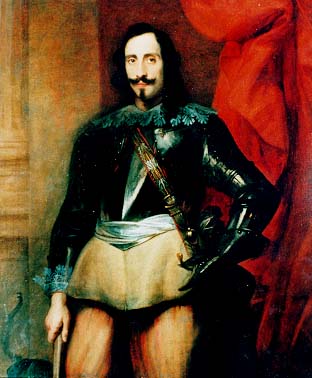SIR ANTHONY VAN DYCK SUMMARY |
General Spinosa of Genoa, ca. 1623 |
SIR ANTHONY VAN DYCK |
| Sir Anthony van Dyck rests in a
unique place in the 17th-century art world as the creator of the Baroque court portrait.
He sense of both elegance and refinement was highly developed. This quality made his
courtly sitters the image of the ideal aristocracy. He was born in Antwerp in 1599 and was apprenticed at the age of ten to Hendrik van Balen. By 1616 he had his own studio and assistants, however he left this to work as the principal assistant to Rubens, between 1618 and 1621. Under Ruben’s influence he modified his hardy early style, and began to use smoother paint with very delicate, silvery tonalities. Van Dyck's early self-portraits are of astonishingly high quality. He portrays himself with rich clothing and a sense of elegance; they underline his claims to be a prince among painters. In 1621 he left for Italy where he spent six years. His longest stays were in Genoa and Rome, however he travelled also to Florence, Venice, and Sicily. He came to love the work of Titian and the Bolognese art of Guido Reni. His sketch books are filled with examples of their work. While in Genoa, he painted a magnificent series of portraits of the aristocracy including the portrait of General Spinosa, shown above. This portrait is typical of his extremely high quality and artistry during this period. Rubens, who was in Genoa 15 years earlier, had created there paintings with a sense of power. Now van Dyck transformed robust power of Rubens into both grace and elegance. In 1627 van Dyck returned to Antwerp where he remained until 1632. At that date van Dyck moved to London where he was knighted by Charles I and named Principal Painter. He was granted a house at Blackfriars where he lived out his life. He visited his native Antwerp twice, but died in London in 1641. Van Dyck's portraits of the English aristocracy revolutionised the art of English painting. His brilliance brought the art of portraiture to new heights of elegance and beauty. His influence in the area of portraiture shaped not only the schools that developed around him but also the works of masters like Rembrandt and Gainsborough. |
